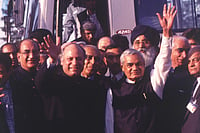Written a year after Adam Sisman’s meticulously researched biography, John le Carre’s autobiography is as riveting as any of his 23 novels written over 50 years. Le Carre is not only the master spy novelist of his time, but as close to literature as the genre permits. A Perfect Spy, inspired by his father, is rated by some as the best English novel since the War. The Pigeon Tunnel, told from memory, is vintage le Carre. Pure memory is “as elusive as a bar of soap” but as Le Carre says, “real truth lies, if anywhere, not in facts, but in nuance”. What makes The Pigeon Tunnel special is that, out of the secret world he once knew, he has created a ‘theatre’ we all inhabit. While providing glimpses of the world of intelligence, le Carre acquaints us with the tradecraft and deep research required of a spy novelist. Spying and storywriting are made for each other, but le Carre provides authenticity to his creations. Much of his writing, like his intelligence work is, however, based on German themes; Germany fed his romanticism and love of lyricism.
Le Carre’s masterpiece remains The Spy Who Came in from the Cold, published while he was still in service. The ‘spy’, le Carre reveals here, originated at a London airport, when a stocky man walked into a bar, ordered a large scotch, finished in two gulps and walked out. Whoever he may have been, in le Carre’s mind he became a spy—Alec Leamas, portrayed with superb, characteristic cynicism by Richard Burton in the movie of the same name. George Smiley was inspired by his mentor in Oxford, Vivian Green, rector of Lincoln College. Yet, when it came to playing him, Alec Guinness insisted on meeting a real spy—the former M16 chief Sir Maurice Oldfield, whose mannerism became a part of Smiley. As the story goes, the legendary R.N. Kao also visited London to consult Sir Maurice whilst setting up the R&AW in 1968.
Yet, le Carre’s intelligence experience is limited. Four years in the MI5 was enough for him before he got himself transferred to the more exciting world of MI6, referred to by his colleagues as “the shits across the park”. Shades of jealousies are endemic in the intelligence world, including the IB and R&AW in India. However, le Carre is candid to admit his huge debt to the security service for the “vigorous instruction in prose” that he got from the “classically trained senior officers” who massacred his loose writing. At one time, India’s Intelligence Bureau could also boast of classical learning that transformed policemen into intelligence officers, even men of letters.
Le Carre has plenty to say about Kim Philby, the British intelligence officer who spied for the KGB. Pigeon Tunnel is full of engrossing anecdotes of fellow intelligence officers, KGB chiefs, Russian defectors and men and women in power. Le Carre tells us that Yasser Arafat was the most spied on individual in history and Saddam Hussain never believed the US would invade Iraq because “they had too many secrets in common”. People at the epicentre, he says, have limited experience of reality. For some strange reason, le Carre refused to meet Philby when he had an opportunity after the latter’s defection in Moscow. He does, however, admit that Philby’s betrayal required courage.
The most fascinating character who emerges from the book is le Carre’s father, Ronnie. His life, we are told, was spent walking on the thinnest, slipperiest of ice. Wherever Ronnie went, the unpredictable went with him. Le Carre says his father was a “five star conman, a crisis addict”. Though he talks of his unhappy childhood, le Carre leaves the last word to his father—more sinned against than sinning, who in fact inspired the author to invent himself. Fact and fiction are so closely intertwined in the genre that one wonders how le Carre would interpret our retaliatory surgical strike. As he acknowledges in the preface, reality would probably prevail over imagination. The Pigeon Tunnel should be a textbook for all intelligence and espionage agencies. If you have been in the circus and not read le Carre, your education remains incomplete.
(A. S. Dulat is a former chief of the Research & Analysis Wing, India’s espionage agency.)
























